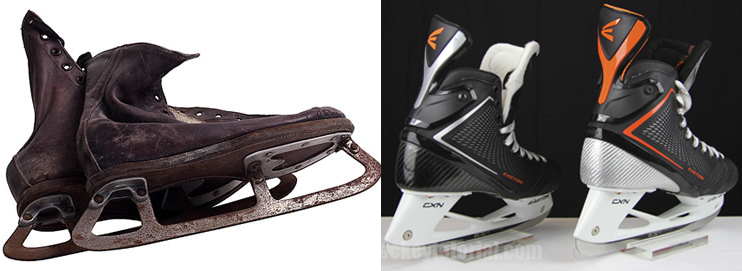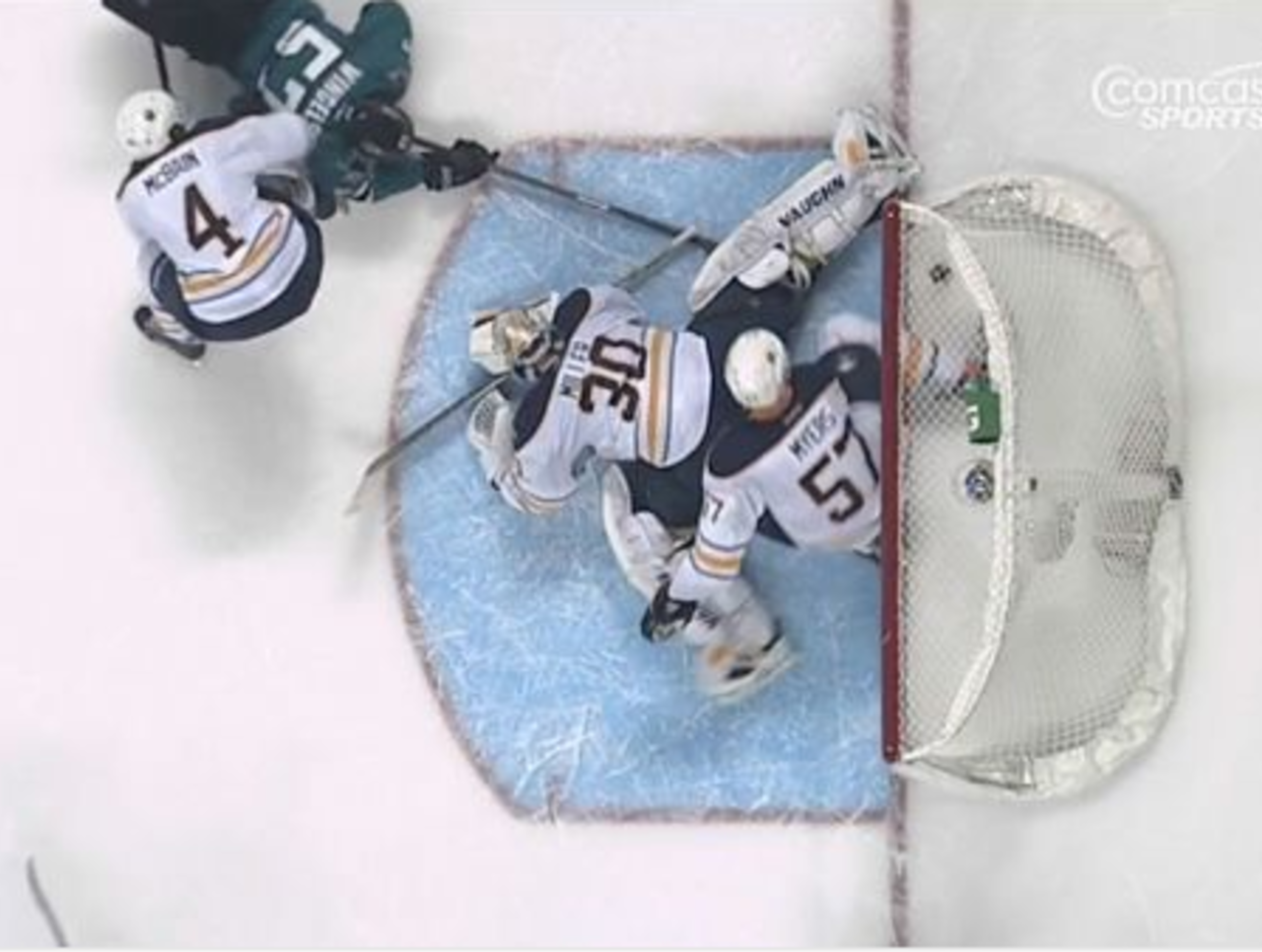Technology continues to change the face of hockey

Back when people started playing hockey, players strapped kitchen knives to the bottom of gumboots and used frozen cattle tails as shooting tools - cattle tails so cold, the players' hands would routinely fuse with their primitive "sticks."
...Yeah OK fine, that didn't happen, but still, most early hockey gear does look pretty primitive when laid aside today's protective materials made of near-weightless, bomb-proof materials.

(That stick above is available at auction, if you have a cool three or four mil kickin' around.)
Below is a quick look at where hockey now stands from a technology point of view. Rest assured, bigger steps are about to be made.
The Gear
Skaters

The bulk of today's protective equipment feels like it's been designed by NASA. The shoulder pads weigh about as much as they did in the '80s, only today you can step in the path of an oncoming van, drop your shoulder, and generally end up okay.
The old ones were ... well ...

...Less, protective, we'll say. (Those are Bobby Hull's old beauties above.)
All protective equipment has followed that trend, with some becoming increasingly form-fitting as it ages, which is quite the perk.
Undeniably, the two biggest areas of development have been in skates and sticks.
Skates
Today's top-end skates take about two ice sessions to break in entirely, and the steel snaps in and out, which means you can bring an extra set of sharpened blades to the bench to swap out when you loose an edge. Those high quality wheels rarely exceed the weight of a puck.
Old skates, however...

...Old skates looked like someone just snapped a pair of scissors in two and somehow screwed the metal onto a pair of vintage Chuck Taylors. Meanwhile, the skates on the right can stop bullets, repel water and if you click your heels three times, will take you home from Oz.
Sticks
The advancement in the quality of hockey sticks is equally impressive (though I'll be honest, if I time-traveled to play hockey in the '40s and had to pick one piece of new technology, I'm bringing the skates).
At this point NHLers are using carbon-graphite wonder-sticks that are responsive, explosive and can even be made softer for those who like a bit more feel.
They've become so precise with the kick points that you can choose your own, you can dial in your own flex and each batch of 12 an NHLer gets has about, oh, 12 useable sticks.
Back in the '70s and '80s you'd be lucky if half the sticks were useable, let alone remotely the same.
Goalies

There was a time when goaltenders stood mask-less and kicked at pucks while wearing 300-pound waterlogged leather pads. And while players didn't get the puck off the ice like they do today, the goalies still took their lumps.
The main changes for goaltenders are not dissimilar to those of skaters: protective equipment has gotten lighter and allows for a bigger range of movement, all while being safer than ever.
With goalie masks no longer being carved from the skulls of vanquished foes (can't find a source for that, sorry) in favor of materials such as fiberglass and Kevlar, goaltenders are more confident than ever between the pipes, as occasionally demonstrated by someone like Henrik Lundqvist.
You've got to trust your bucket to headbutt a slapshot.
The Video

Game planning
Roger Neilson was a well-known pioneer of watching video (tough to earn the nickname "Captain Video" without that habit), which was the first step towards today's common video-based pre-game planning strategies.
Neilson was a video analyst for the Edmonton Oilers in 1984, while opposing teams made foolish plans like "let's shadow Wayne Gretzky" - a poor idea that involves a player running wildly out of position while trying to track a guy who A) knows where he's going, and B) is just flat-out better than said chasing player. Video allowed teams to make more thoughtful, complex plans.
Hockey today is more positionally stringent, so it's advantageous to take hours before the game to show a team the weaknesses and strengths of their opponent, and how to plan an attack on both. Players can study their opponents' penalty kill and power play, and take aside groups of their own players to plan how they'd like to counter.
In-game adjustments
Video isn't just for pre-game plans, as most teams employ some sort of "eye in the sky" that can tag game moments on video to watch at intermission, which means teams can make adjustments on the fly. This is a big one these days - calling a player or players into a room to point out "Look, they have their left D pinching on the walls, so let's stop trying to go up the right side" can eliminate your squad from getting hemmed in your own zone for long stretches.
iPads for pre-shootout scouting
You're starting to see more iPads on benches, as there are more programs to help diagram plays with each passing month. And for goaltenders before shootouts, it can be good to have a reminder of the preferences for each shooter.
The Future

We've come a long way from having a single ref making calls based purely on what his eyes tell his brain. These days, you've got two referees and video with a boatload of angles to help them get calls right.
But, even that isn't enough sometimes, as attested by this "no goal" call in overtime just last season...

...So that's not where this ends.
The NHL is about to test a new angle by putting cameras in the posts, which would allow them to make the definitive call on whether a puck crossed the line. From there, rumors persist about installing a chip in the puck to make the official ruling even if the puck can't be seen.
For teams, technology is leading towards player tracking as shown in other sports such as soccer, so we can tell how far a player traveled in a given game (or shift, or period), how fast his average speed is, what his top speed was and more.
Technology will continue to change with gear, but the biggest changes are coming in player evaluation and game-planning. Where "the eye test" allows some mediocre players to hide in today's NHL, they'll be exposed tomorrow.